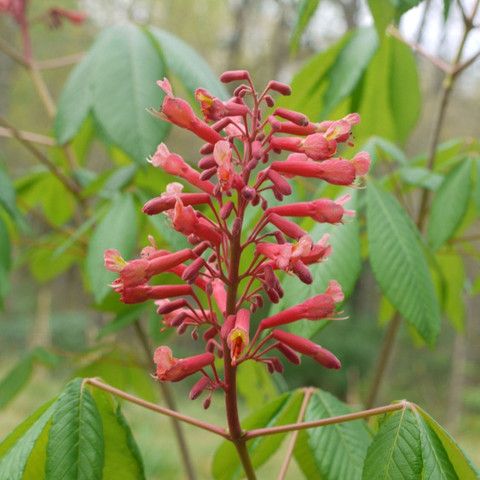A Tree Grows in the Paca Garden - Part 3
- HistoricAnnapolis

- Jun 27, 2020
- 2 min read
Down at the bottom of the Paca Garden, this tree next to the summer house has an interesting history, with a bit of mystery.

In 1784, near the border of present day Pennsylvania and West Virginia, George Washington collected seeds from a naturally occurring hybrid of the red buckeye
(A. pavia) and the yellow buckeye (A. octandra, sometimes called A. flava) - the Aesculus x hybrid.
At that time the location was too far north for the red buckeye to grow, because it preferred warmer, humid climates. Botanists have been arguing about how it came to be there ever since. Perhaps the red buckeye was introduced, or the hybrid was. John Bartram (you may remember him as a Philadelphia Quaker who was appointed the Royal Botanist for North America) was growing red buckeye in his garden in 1760, and William Bartram listed both red and yellow buckeyes in his Garden Catalogue of 1783, although not their hybrid. By the next year, he was sending the trees to Europe, especially England and France. Thomas Jefferson had red buckeyes at Monticello, in an open area below the lawn, where he planted widely-spaced native trees, among them, the crabapple with its pink blooms, white-flowered umbrella magnolia, and red buckeye.
Washington planted the buckeye seeds he found in 1784 at Mount Vernon, where they flourished. Several trees planted by Washington survived through the end of the 20th century, including the buckeye hybrid, now known as "Washington's Buckeye." Our Paca Garden buckeye was grown from a cutting of one of these Mount Vernon survivor trees, planted by Washington. (Note that when a tree is said to be “planted” by Washington or Jefferson, those men were the landscape designers, but the actual physical work was done by enslaved gardeners.)

Trees in the Aesculus genus have easily identifiable large, distinctive, palmately compound leaves with 5-7 leaflets. They are one of the few trees native to America with opposite leaves, another easy way to identify them. They have perfect flowers, meaning that each flower contains both the male and female reproductive structures. The red buckeye, native to the southeastern US, grows to 20 feet. It has long been much desired by gardeners because of its dramatic red flowers in Spring. And the yellow buckeye, growing to 90 feet, is often called the most beautiful tree in the Aesculus genus. Red and yellow hybridize naturally, to the point where it is sometimes difficult to identify them. There are at least seven known hybrids. A. pavia x octandra does best in horticultural zones 6-9.
Trees in the Aesculus genus produce the toxin aesculin, which makes the seeds, twigs, and leaves poisonous to humans and animals. Native Americans threw ground-up leaves in the water to catch fish; then, after the fish were stunned or killed, they were easily gathered up. They also soaked buckeye seeds to remove the poison so that they were edible, so perhaps they also soaked the poisoned fish before eating them.

The Paca Garden buckeye’s large, showy flowers attract both pollinators like bees and hummingbirds and human visitors to the garden, ensuring its place of honor in our arboretum.
Dolores Dyson Engle
William Paca House and Garden Docent












Comments